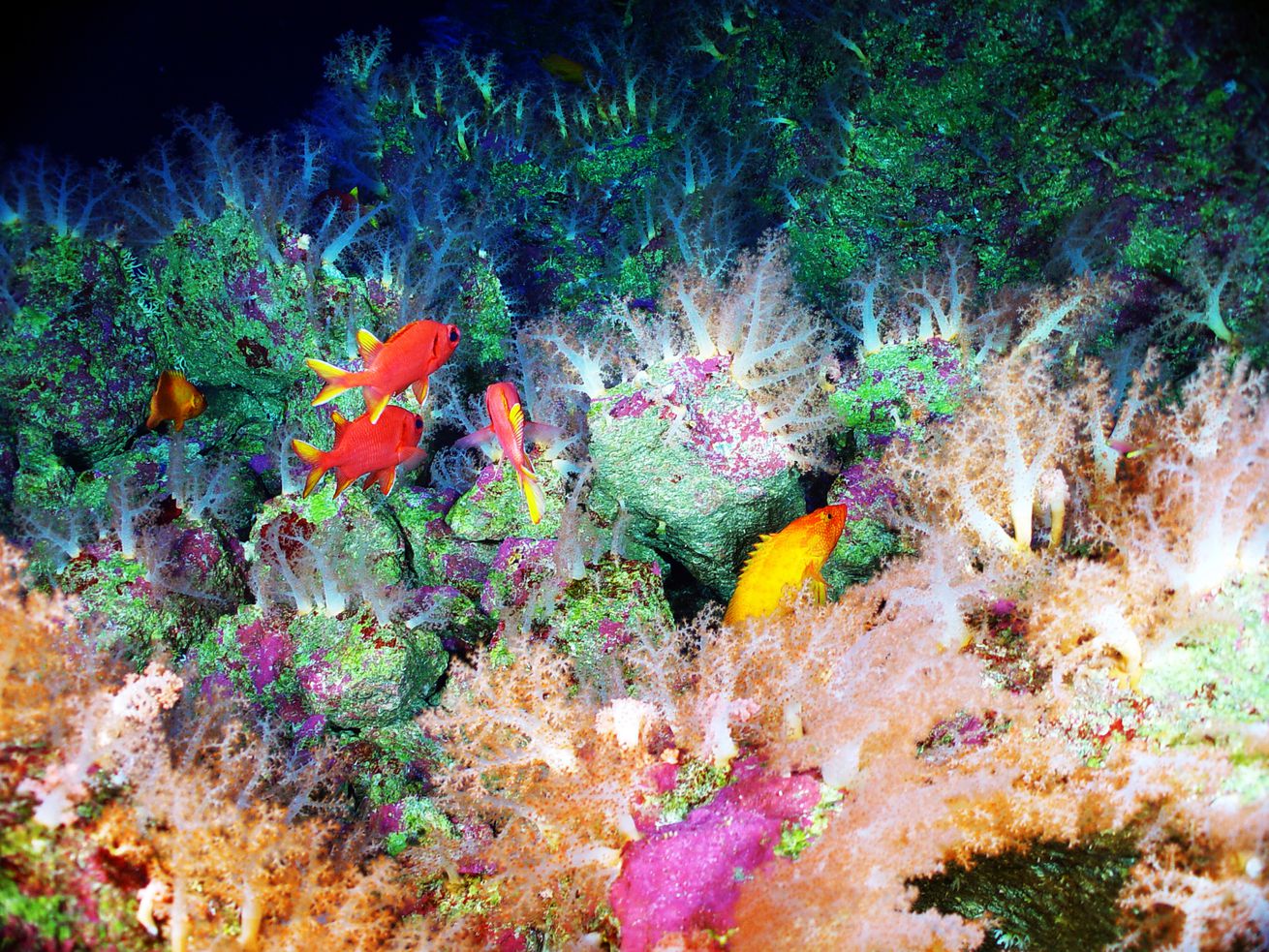Yet the threats these castles of biodiversity face are mounting.
This story is part of Down to Earth, a Vox reporting initiative on the science, politics, and economics of the biodiversity crisis.
Bill Chadwick has seen things you wouldn’t believe. He’s observed an undersea volcano oozing carbon dioxide, which turned into an eerie, milky liquid under the intense water pressure. “That was crazy,” Chadwick tells Vox. He witnessed another eject a toxic plume that was killing and stunning fish and squid, which rained down to be eaten by crabs, worms, and shrimp.
Chadwick, a researcher at Oregon State University’s Hatfield Marine Science Center, has spent much of his career exploring the ocean’s depths as a seafloor geologist. He says nothing is quite as wondrous as an underwater volcano.
One of Chadwick’s all-time favorite expeditions was to the Mariana Arc, a chain of mostly submerged volcanoes south of Japan. Between 2004 and 2010, remotely operated vehicles (ROVs) glided around this previously unexplored realm, surveying its volcanic cathedrals — some nearly breaking the waves, some concealed a mile beneath. The eruption of an underwater Arc volcano known as NW Rota-1 — the same one emitting the plume that knocked out fish and squid — marked the first time a deep-sea volcano had been seen spewing molten rock.
Earth is covered in volcanoes, and most of them are in our oceans. If you could merge all known underwater mountains and active underwater volcanoes, their total area would be roughly equivalent to that of Europe and Russia combined. And whether those volcanoes are long dead, adorned with hydrothermal vents, or erupting hellfire, expeditions like those to the Mariana Arc show a world teeming with life. This life, though, is difficult to investigate, and not just because it takes a lot of expertise and pricey technology. “The ocean,” Chadwick says, “is the great hider.”
One of Earth’s most underappreciated biodiverse habitats is, for now, mostly a mystery. That’s left a chasm in the collective understanding of the full extent of our largely detrimental effects on the world’s watery domains. And the threats these habitats face, from warming oceans to commercial fishing to a controversial, nascent deep-sea mining industry, are mounting.
A disquieting race is now afoot. Conservationists are toiling away, hoping that protective measures and standards are agreed upon and in place long before any future waterborne enterprises get their own shot at the seafloor — and, in the process, potentially inflict lasting damage on unknown ecologies obscured by the depths.
Castles of biodiversity
Humans have explored only a tiny fraction of the deep sea, so we don’t know exactly how many seamounts are out there. (Some scientists use “seamount” to refer to any underwater volcano, but many associate that word with any significant topographic highs on the seafloor, the vast majority of which are extinct volcanoes.)
/cdn.vox-cdn.com/uploads/chorus_asset/file/22708177/629464159.jpg) Universal History Archive/Universal Images Group via Getty Images
Universal History Archive/Universal Images Group via Getty ImagesMany ancient seamounts that scientists have observed host fields of corals and sponges. Brennan Phillips, who specializes in ocean engineering at the University of Rhode Island, has explored seamounts for most of his career using ROVs, and recalls visiting a seamount chain off New England that is thousands of years old and coated in coral gardens. “You really get the feeling that you’re looking at something sort of sacred, that’s so old that you shouldn’t even touch it,” he says.
These sponges and corals provide the foundations for an underwater jungle, explains Verena Tunnicliffe, a deep-sea biologist at the University of Victoria. They trap food particles, offer shelter, and provide places for creatures to lay their eggs or nurture their young. Small fish and crustaceans hang around them, attracting larger marine animals, like sharks and whales.
From the limited number of expeditions conducted to date, scientists have found that while seamounts are teeming with life, few appear to have species unique to them. “They’re biodiversity hot spots,” says Lissette Victorero, a marine macroecologist at the Norwegian Institute for Water Research, but not necessarily hot spots of lifeforms endemic to just those areas.
Seamounts function as waystations: oceanic outposts where life can seek refuge, refuel, and raise offspring before moving on. Either through ancient transit routes that no longer exist or contemporary ocean currents, many of the same lifeforms — from foundational species like coral to vagabonds like shrimp and sea turtles — can be found at seamounts throughout the same ocean, or even in two different oceans.
/cdn.vox-cdn.com/uploads/chorus_asset/file/22708951/corals.jpeg) NOAA Office of Ocean Exploration and Research
NOAA Office of Ocean Exploration and Research/cdn.vox-cdn.com/uploads/chorus_asset/file/22708845/FK161129_Two_TowersHoffman20161212.png) Schmidt Ocean Institute
Schmidt Ocean InstituteIf seamounts — mountains bereft of volcanic violence or chaotic chemistry — are oases of life, active undersea volcanic environments are far more hostile.
Their geologic architecture is more alien and ephemeral, says Phillips. The Aegean Sea’s Kolumbo submarine volcano, for example, features a giant cauldron filled with deoxygenated, corrosive water — surrounded by steep walls of crumbling rock. “It’s like Mordor; it just looks wild,” he says.
At the Lost City Hydrothermal Field in the Atlantic are spiraling columns of rock and pillars of frozen lava. Seeping hydrothermal fluids have created shimmering, reflective, teal-tinted pools suspended in the sea.
But even here, life finds a way. Microbes resistant to high temperatures and extreme pH levels form the basis of food chains. They gobble up hydrogen, iron, sulfur, carbon dioxide, methane, and other compounds that escape from chimney-like hydrothermal vents or fissure-like seeps, converting them into energy.
Most animals cannot handle the conditions of active volcanic or hydrothermal systems, including many sponges and coral. But some hardy crustaceans and fish survive. These places are less biodiverse than seamounts overall, says Victorero, but are home to creatures that are more specialized — and just plain weird.
/cdn.vox-cdn.com/uploads/chorus_asset/file/22708615/seep_octopus.jpeg) Ivan Hurzeler and DEEP SEARCH 2019 via NOAA
Ivan Hurzeler and DEEP SEARCH 2019 via NOAAThese ecosystems are hard to study — but we could learn so much
Despite forming one of Earth’s most expansive habitats, more than 96 percent of seamounts have not been studied, says Victorero.
Using satellite-based radar surveys, which can detect mile-high bumps on the seafloor, scientists have determined “there’s something on the order of 30,000 seamounts around the world,” according to Phillips. The total could be closer to 100,000.
Crewed submersibles have paid a visit to some of these way-down habitats, but surveying them in detail is usually done from a ship — though manually piloted robots and autonomous underwater vehicles have given scientists valuable close-up views.
/cdn.vox-cdn.com/uploads/chorus_asset/file/22708148/FK161129SuBastian_Preparing_for_a_chimney_sample.png) Schmidt Ocean Institute
Schmidt Ocean InstituteSeamounts and active volcanic and hydrothermal systems are incredibly difficult, time-consuming, and expensive to reach. With the training and cutting-edge technology needed to run one of these expeditions, visiting an underwater volcano “is almost like visiting another planet,” says Chadwick.
Remotely operated underwater vehicles, though revolutionary to ocean science, have limited fields of view. Like a climber only ever seeing the part of the mountain right in front of them at any given time, these robots are likewise restricted to seeing or sensing only what is in their immediate vicinity. “You’re using a microscope to explore a gymnasium,” says Phillips. “There’s a lot that you’re going to miss.” Most major zoological discoveries happen serendipitously, like the chance sighting by an ROV of a sprawling octopus nursery off the California coast in 2018.
Underwater volcanoes are “absolutely everywhere,” says Julie Huber, a marine microbiologist at the Woods Hole Oceanographic Institution. “And we’ve barely looked at any of them.”
Researchers like Huber want to know how these enigmatic ecosystems work — and so do astrobiologists. Space is a hostile place, yet our solar system contains moons with surprisingly warm subsurface oceans. “We want to find weird life in the universe,” says Chadwick, but “there’s a lot of weird life we don’t know about on our own planet.” The more we learn about deep-sea life here, the better prepared we’ll be when searching for off-world aquatic organisms.
What we do know about undersea volcanoes in our own oceans is that they already provide plenty of food for people — one of the many reasons there is widespread concern about overfishing these areas. Their microbes, too, support scientific ventures on dry land: Pyrococcus, a type of deep-sea vent microbe, has an enzyme that can be used to copy DNA with remarkable accuracy, a process used to detect elusive viruses and amplify cryptic DNA at archaeological sites and crime scenes.
Many of these habitats also have indicator species, such as corals, which can provide valuable information about the health of the seas.
Warmer, more acidic, less oxygenated seas — our future thanks to climate change — are anathema to most life. Seamounts could actually provide a refuge for a diaspora of marine life as the climate crisis intensifies, says Victorero. Should shallower waters become too toasty for certain critters, some researchers suspect that these animals may be able to hang about in communities that remain relatively unharmed — for the time being — on the lower, deeper slopes of underwater volcanoes.
Commercial fishing is already a threat, and mining might be next
Meanwhile, a commercial fishing technique known as bottom trawling, which dates back to the 14th century, continues to tear up parts of the deep today. Giant, weighted nets bulldoze across the seafloor, including seamounts, catching large quantities of fish and shellfish. A wealth of research has shown that bottom trawling not only annihilates huge swaths of biodiverse habitats — unleashing massive amounts of carbon in the process — but that those habitats can take decades to recover, if they recover at all.
The US, or any other coastal nation, can essentially fish however it wishes within its national waters, an area up to 200 nautical miles from its shores. But what happens in international waters is another story, explains Matthew Gianni, cofounder of the Deep Sea Conservation Coalition.
At the turn of the millennium, deep-sea fishing on the high seas was regulated by a series of regional treaties that provided only minimal regulations in much of the world’s open waters. Some stretches — the North Pacific, South Pacific, and Southern Indian Ocean — were completely unregulated, says Gianni. Fortunately, he notes, through sustained scientific research and intensive conservationist efforts, roughly three-quarters of international waters are formally off-limits or provisionally closed to bottom trawling today.
Countries largely adhere to these regulations, making this not only a success story — albeit one still in progress — but potentially a model that other efforts focused on seafloor conservation can emulate. As conservationists work to expand protections for biodiversity hot spots, including seamounts, however, they’re wary of another potential problem: deep-sea mining.
The seafloor is packed with valuable metals: cobalt, copper, gold, zinc, manganese, and nickel, all currently used in an array of electronics. These materials are found in potato-sized, rocky-metallic nodules on the ocean floor, in hydrothermal vents, and within the crusts of seamounts. And companies want to get them.
/cdn.vox-cdn.com/uploads/chorus_asset/file/22708430/Konkrecje_na_dnie_oceanu.jpeg) Abramax / Wikimedia Commons
Abramax / Wikimedia CommonsDeep-sea mining doesn’t yet exist in practice. The technology required to extract metals from these environments (such as chipping or strip-mining valuable chunks off the seafloor and sucking them up to a floating rig) is still in prototype phase and somewhat prone to fail.
For now, we simply don’t know the potential scale of deep-sea mining’s effects, from the removal of parts of the seafloor itself to the release of toxic metals into the water column. And because of the dearth of data about deep-sea ecosystems more generally, a growing number of ecologists and environmentalists are understandably nervous.
Although active hydrothermal vents generally recover quickly from being damaged, many inactive seamounts don’t, says Victorero, as evidenced by bottom trawling. That style of fishing removes living things, whereas strip-mining seamounts’ crusts would remove their rocky underplating, potentially causing even more destruction. And destroying these common waypoints for creatures may disrupt the flow of life through the ocean, says Tunnicliffe, the deep-sea biologist.
Many ecologists and environmentalists advise caution, urging that mining not proceed until we learn more. (Sir David Attenborough, perhaps the world’s best-known naturalist, is among the critics warning about deep-sea mining’s impact on both biodiversity and the climate.)
Last month, a group of more than 300 scientists and policy experts representing 44 countries called for a pause to prevent deep-sea mining work from moving from exploration to exploitation. The European Parliament called for a moratorium on deep-sea mining in 2018 until the risks are better understood, and earlier this year, BMW, Volvo, Samsung, and Google called for a similar pause.
Ultimately, deep-sea mining hasn’t gotten off the ground because it’s not yet economically viable. “They’re not going to do if it they don’t make money,” says Cornel de Ronde, a geologist at GNS Science in New Zealand. But it may one day prove profitable, de Ronde adds.
As with international fishing regulations, nations can more or less mine within their national waters with impunity. But most of the world’s seamounts, active volcanoes, hydrothermal vents, and oceanic plains are in international waters, which could, theoretically, be regulated through new international treaties. That’s an opportunity — if reasonable regulations can be agreed to and followed.
International mining regulations are opaque and sideline scientists
No company can “just go out to the high seas and say, ‘I wanna mine the seamount,’” says Kristina Gjerde, a high-seas policy adviser with the International Union for Conservation of Nature. “You actually have to get permission.”
In this case, permission would come from the International Seabed Authority, or ISA, a group of 168 members — 167 countries plus the European Union — that arbitrates where in the high seas deep-sea mining can take place. (Largely because of conservative opposition to international treaties and organizations, the US is not part of the ISA.)
This autonomous body operates under the UN Convention on the Law of the Sea and has to date given out 31 exploration contracts to 22 contractors for deep-sea mining. These contracts permit survey work: testing mining equipment on a small scale, assessing the mineral content and grade of sites, and collecting environmental information in the claim area. The ISA has not yet awarded any contracts to conduct full-on mining operations in international waters, but there’s concern among conservationists and ecologists that the ISA could do so without proper regulatory oversight.
Mining entities that wish to explore or extract polymetallic nodules need to submit environmental impact reports, explaining how their work will or won’t damage, say, the seamounts they want to target. But the ISA lacks an internal scientific committee that can verify the accuracy of those reports, according to Gianni. Like much of the ISA’s data and decision-making processes, these reports are not made available for independent, external review by scientists.
“It’s not going to be a well-regulated industry if it’s not open,” says Victorero, the marine macroecologist. The ISA did not return a request for comment.
Industry proponents say that mining cannot be seen exclusively as an ecological threat. For example, several metals found in the seafloor can be used in low-carbon technologies, such as electric car batteries, wind turbines, and solar panels.
Campaigners and scientists have been formally negotiating with the ISA since 2017 to develop regulations and protocols for any future exploitation contracts. The ISA now has two years to finalize deep-sea mining regulations, after the island nation of Nauru (which has partnered with the Canadian metals company DeepGreen) recently gave the UN an ultimatum: They officially declared their intentions to conduct deep-sea mining operations. As is a state’s legal right, Nauru is permitted to commence deep-sea mining in 2023 under whatever regulations — rigorous or otherwise — are in place by then.
Ideally, says de Ronde, there would be compromise. For example, perhaps only seamounts with unique biological species or that seem to be more vital waystations for meandering life would be off-limits for mining.
/cdn.vox-cdn.com/uploads/chorus_asset/file/22709041/FK161129_Control_Room_Crew2_12_12_2016.jpg) Schmidt Ocean Institute
Schmidt Ocean InstituteTo really know which seamounts deserve unequivocal protection, they need to be comprehensively studied. But we don’t need to know absolutely everything, says Tunnicliffe; just enough to properly model things.
Scientific research gets a financial pittance from most governments, however. Politicians have been reticent to boost deep-sea expeditions in the name of discovery alone. If the deep-sea mining industry was serious about protecting the sea, it would be investing a lot more in funding ecological and environmental research, says Victorero.
One strategy that may prove fruitful, says Tunnicliffe, is improving efforts to showcase the wonders of the deep to the general public. The US government’s Okeanos Explorer, for example, is a popular vessel probing the depths and sharing what it finds.
If such discoveries are shared more broadly, it may change how we see the castles of the deep, from the Mariana Arc to the Sur Ridge seamount off the California coast and beyond, encouraging those in power to fund more expeditions — and protect them from future threats.
“Once you shine a light on any of these ecosystems,” says Tunnicliffe, “you’re just going: ‘Oh my God, it’s just so beautiful!’ It hits part of you that is your soul.”
Author: Robin George Andrews
Read More



